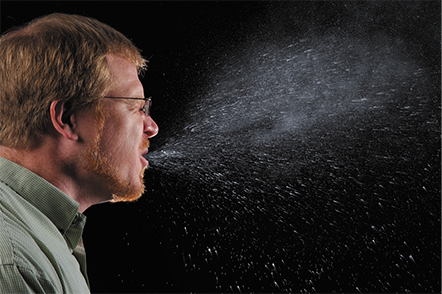12.2 Sources of Contamination
Microbes cannot cause an infectious disease unless they are transmitted to humans and enter their bodies. This can occur through inhaling, ingesting, touching mucosal linings, contact with piercings or open sores, or injection. Unfortunately, these transmission processes are easily accomplished without knowing it through various avenues, including touch, air, and water. One must be keenly aware of the modes of microorganism transmission in order to understand how to control infection and to avoid contamination during hospital work and the preparation of compounded sterile drug products.
Touch
Besides living on our skin, millions of bacteria live in our hair and under our nails. Therefore, properly washing hands and fingernails is essential in all hospital work. Following the strict recommended procedures before handling and preparing sterile materials is also essential. Touching is the most common method of contamination and the easiest to prevent. In addition to frequent handwashing, the use of disposable gloves can minimize touch contamination, which is why they are commonly used by healthcare personnel.
 Safety Alert
Safety Alert
Nonsterile touch is the most common and dangerous source of contamination, especially when performing sterile compounding—even when wearing gloves.
Air
Microorganisms inhabit the air by floating, resting on dust particles, and inhabiting moisture droplets. For this reason, sterile compounded products need to be prepared in a designated area where these possible contaminants are minimized to as low a level as possible. Special equipment within these areas controls airflow and filter contamination, as will be discussed later in this chapter.

Sneezing causes air contamination up to seven feet by emitting thousands of microorganisms in tiny water particles.
Water
Moisture droplets in the air, especially after a sneeze or cough, often contain harmful microbes. Even tap water is not completely free of microorganisms. Exposure to droplets of tap water or other sources of moisture can contaminate sterile compounds, which is why distilled, sterile water is used in various pharmacy cleaning and compounding procedures. Any pharmacy technician assigned to prepare sterile products who has a common cold should notify his or her pharmacist supervisor for a temporary change in work functions. Sterile compounding personnel use special techniques and garb to reduce or eliminate potential moisture contamination.